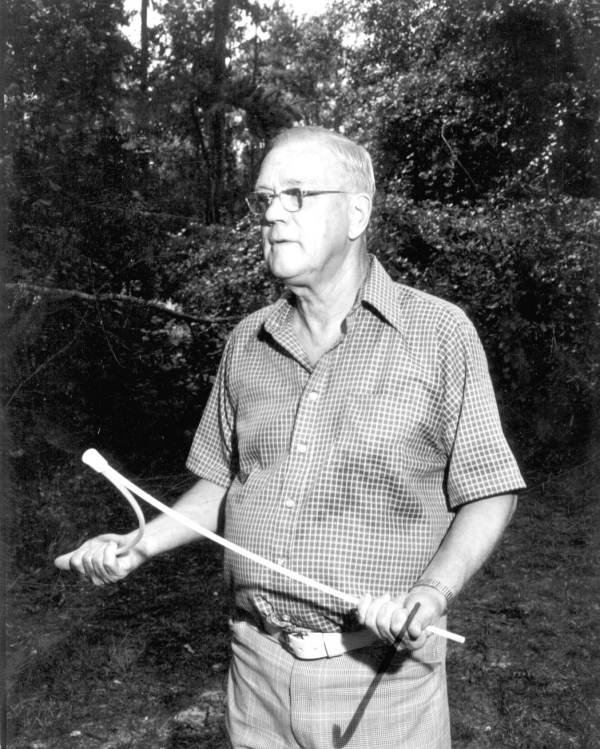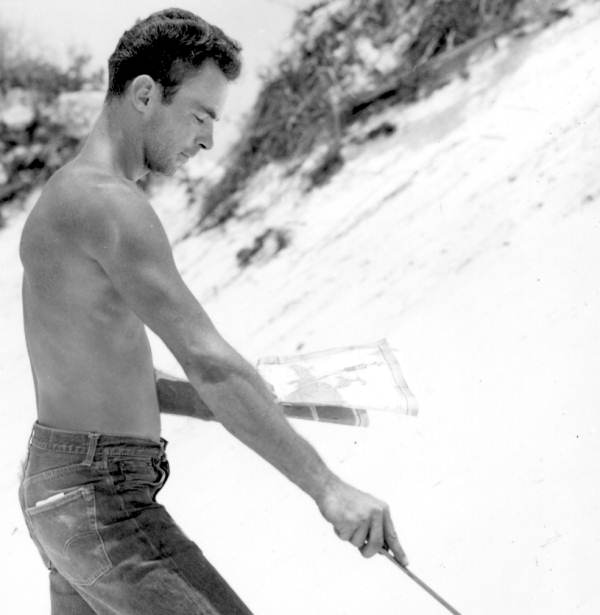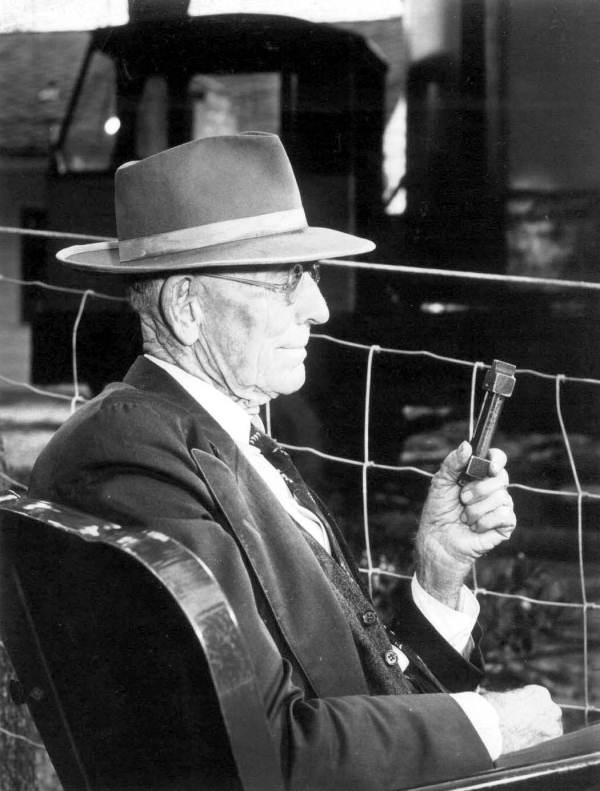Description of previous item
Description of next item
Water Witching
Published May 5, 2018 by Florida Memory
After reading The Wizard of Oz or watching the film adaptation, you may have come away thinking that witches and water don’t mix. Not so! In fact, people have been “witching” for water, oil, gold and other hidden things for thousands of years.
So-called water witching is the practice of locating a source of underground water using a simple tool, usually a Y-shaped object called a dowsing rod or divining rod. The traditional dowsing rod is often made from a local tree or bush, but some water witchers use brass, copper, nylon or even re-purposed objects like clothes hangers and wire.
Water witching has a long history, some even applying the term to the Biblical Moses striking a rock with his staff and causing water to flow from it. African cave paintings from 6,000-8,000 years ago found in the Atlas Mountains appear to depict water witching, and references to the practice appear in the ancient writings of Indian, Chinese, Egyptian and Persian thinkers. Evidence suggests dowsing first appeared in Europe in the 16th century, as dowsers attempted to divine sources of certain minerals. As Europeans began making their way to North America, they brought dowsing with them, and soon the practice became ingrained in the popular imagination as a legitimate way to prospect for water.
The procedure for water witching is deceptively simple. The operator holds the dowsing rod or other divining tool with palms facing up, thumbs outward and the tip of the rod pointing upward. As the water witcher walks along, the presence of underground water “pulls” the tip of the rod downward, allegedly with enough force in some cases to twist the bark on the handles of the rod. Science has yet to account for this phenomenon, but those who practice water witching and believe in its legitimacy say it’s all about the skill of the witcher. “You can either do it or you can’t do it,” longtime Florida Folk Festival director Thelma Boltin once said of it. Plenty of people certainly tried their hand at it while visiting the festival, with guidance from professional water witchers like Lonnie Morgan of White Springs and Don Thompson of Clearwater.
Here’s a brief audio clip of Lonnie Morgan explaining the art of water witching at the Florida Folk Festival in 1963, with some commentary from Thelma Boltin:
From recording T77-140, Florida Folklife Collection (Series S1578), State Archives of Florida.
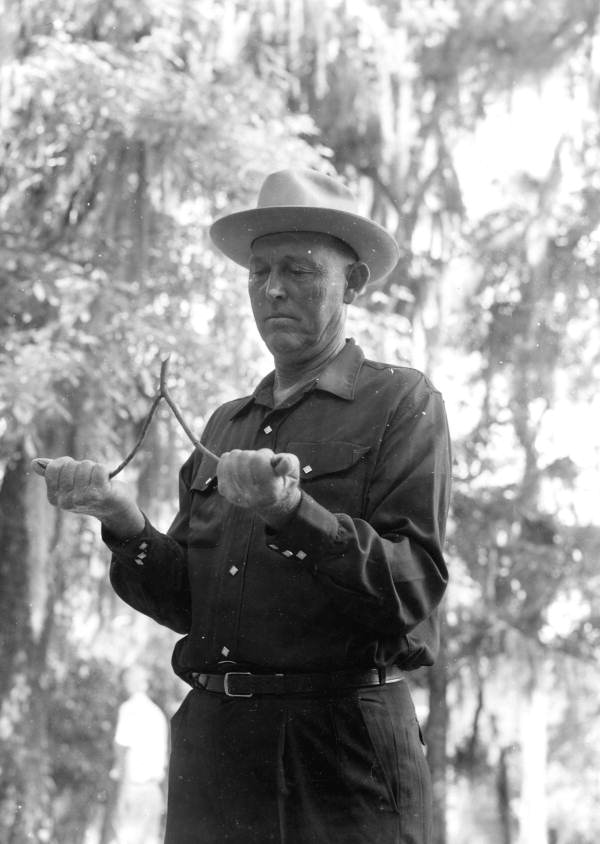
Water witcher Lonnie Morgan of White Springs holding a dowsing rod at the Florida Folk Festival in 1958.
Dowsing rods have also come in handy for treasure hunters looking for other hidden goodies, like gold and silver coins and other objects. In the photo below, for example, we see a man using a dowsing rod to search for lost items on a beach in Pensacola. Whatever your thoughts about the merits of dowsing, you have to admit it’s less cumbersome than carrying around a metal detector!
In at least a few cases, dowsing rods have been at the center of much bigger, more dramatic Florida treasure hunts. George B. Mobley of Green Cove Springs made the news on several occasions in the 1940s and early 1950s with his divining rod and fantastic stories of buried Spanish pirate gold. In 1945 and again in 1948, Mobley got permission from city officials in Green Cove Springs to dig for treasure under a busy city street. He was bonded to ensure the damage to public property would be repaired, but Mobley was confident his venture would produce many times the value of what the repairs would cost.
Both times, Mobley’s digs encountered natural obstacles, mainly the encroachment of water and quicksand into the shaft. As the 1948 dig grew deeper and still nothing was found, reporters repeatedly asked him if he might have made a mistake. “No sir,” he told the United Press, “it’s down there and as soon as we get all this muck out of the hole we’re going to dig it right up.” At one point during the excavation, Mobley decided to take his “money finding” divining rod into the open shaft to get a fresh reading on the gold to see how much farther his workers could expect to dredge. Mobley, at that time in his early 80s, was in no shape to go alone, so he sat on the lap of his chief contractor, J.T. Conway, as a crane lowered them both down into the hole.
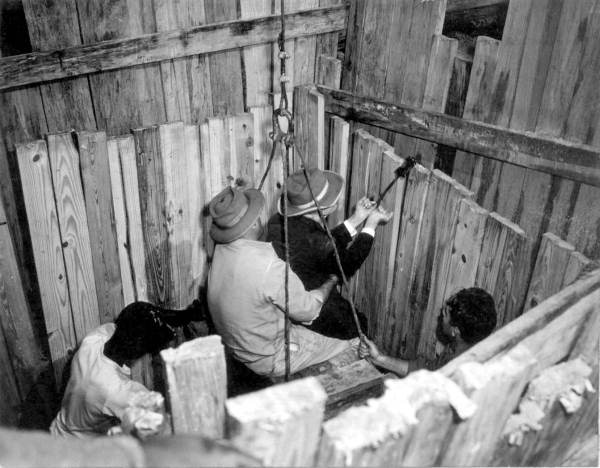
Contractor J.T. Conway holds treasure hunter George B. Mobley on his lap as a crane lowers them both into an open shaft in Green Cove Springs. Mobley is seen holding his “money finding” device on the end of a divining rod (1948).
Mobley’s treasure hunt ended without much to show for the work. Although the team brought up a few metallic items they claimed could be connected with buried pirate treasure, they did not find the gold bars or coins they had believed were waiting for them. “The gold’s there all right,” Mobley said, “but now I think it’s gold dust instead of gold bars or coins and the dust has been mixed with the sand. We just couldn’t find it.”
While dowsing rods and similar devices haven’t proven very effective at pointing out sources of gold, water witching is still alive and well in the 21st century. In fact, there’s still an active American Society of Dowsers with chapters right here in Florida! The U.S. Geological Survey and the National Ground Water Association both point out that the philosophy behind dowsing doesn’t stand up to scientific scrutiny, yet they continue to field questions about it from the public, and both groups have found it necessary over the years to publish leaflets addressing the practice.
What kinds of treasure have you discovered in your corner of the state? Leave us a comment, and don’t forget to share this blog with your friends on Facebook or Twitter.
Cite This Article
Chicago Manual of Style
(17th Edition)Florida Memory. "Water Witching." Floridiana, 2018. https://www.floridamemory.com/items/show/332833.
MLA
(9th Edition)Florida Memory. "Water Witching." Floridiana, 2018, https://www.floridamemory.com/items/show/332833. Accessed December 24, 2025.
APA
(7th Edition)Florida Memory. (2018, May 5). Water Witching. Floridiana. Retrieved from https://www.floridamemory.com/items/show/332833

 Listen: The Folk Program
Listen: The Folk Program